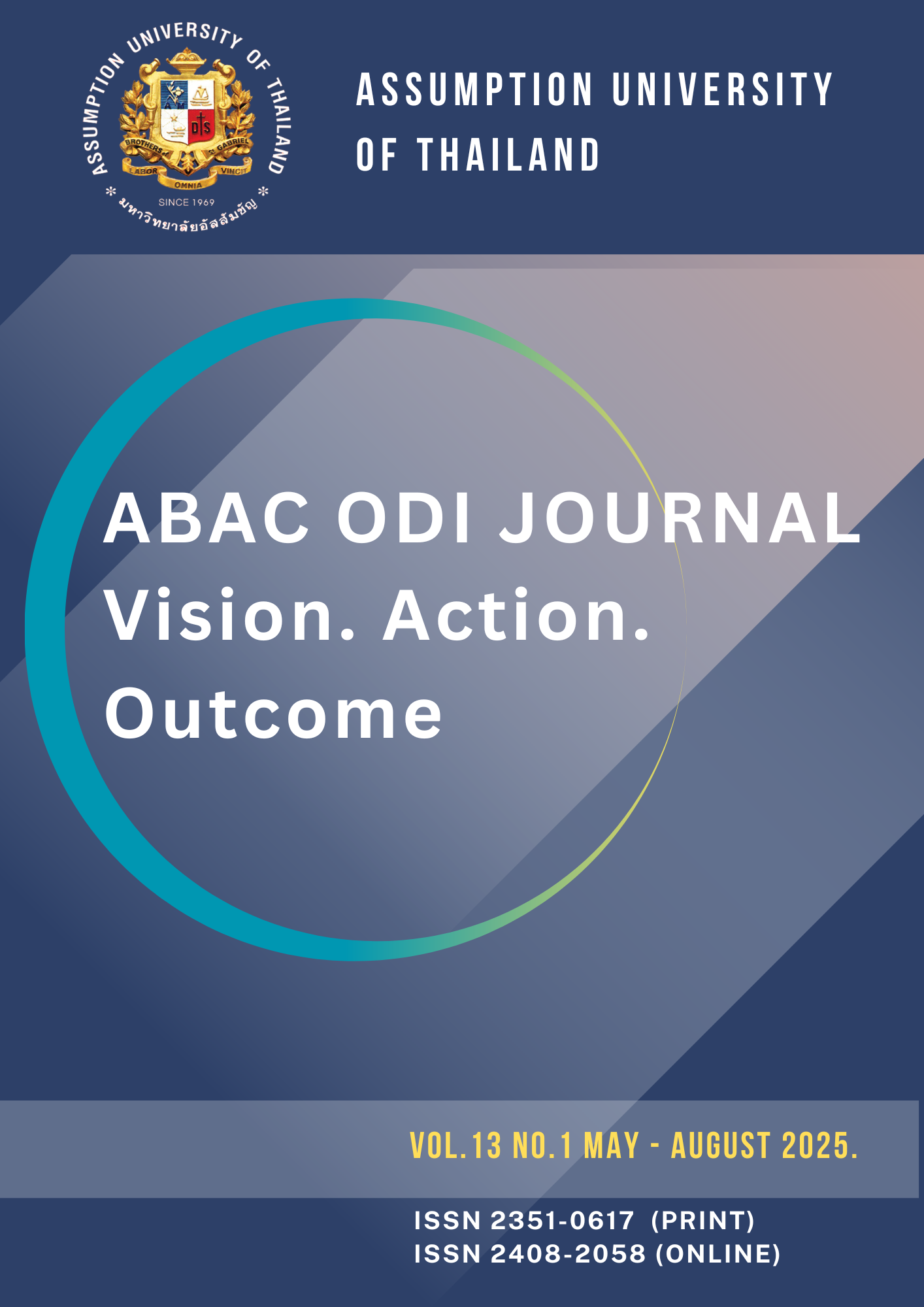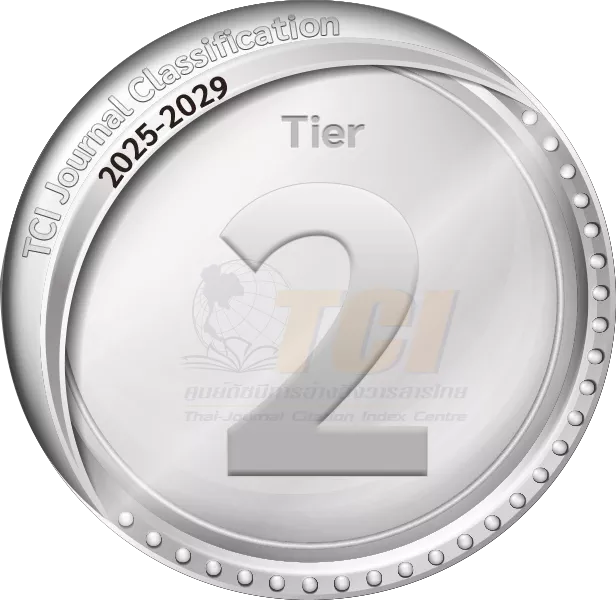The Mediating Role of Non-verbal Behaviors in the Relationship Between Interdependent Self-construal and Transformational Leadership
DOI:
https://doi.org/10.14456/abacodijournal.2025.19Keywords:
Transformational Leadership, Nonverbal Behaviors, Self-ConstrualAbstract
This study examined the relationship between interdependent self-construal and perceptions of transformational leadership, and the mediational role of non-verbal behaviors that reflect intention to build relationship (ITBR). One hundred and forty business managers took part in a multiphase study. In phase 1, they delivered speeches while being recorded. In phase 2, their non-verbal behaviors were coded by independent coders using Laban Movement Analysis. In phase 3, different independent coders listened the participants’ speeches and rated their level of transformational leadership. Structural Equation Modeling (SEM) and bootstrapping analyses were utilized to test several mediational paths. The results supported our hypothesis that nonverbal movements, specifically light weight, free flow, indirect space and process-oriented movements, mediated the relationship between interdependent self-construal and transformational leadership. The theoretical and practical implications are discussed within the context of self-construal and leadership theories.
References
Antonakis, J., Bastardoz, N., Jacquart, P., & Shamir, B. (2016). Charisma: An ill-defined and ill-measured gift. Annual Review of Organizational Psychology and Organizational Behavior, 3(1), 293-319. https://doi.org/10.1146/annurev-orgpsych-041015-062305
Bass, B. M. (1985). Leadership and performance beyond expectations. Free Press.Bass, B. M. (1999). Current developments in transformational leadership: Research and applications.The Psychologist-Manager Journal,3(1), 5-21.
Bradley, K. K. (2018). Mastery of Movement for the Twenty-First-Century Performer. Routledge.Conger, J. A. (1989). The charismatic leader: Behind the mystique of exceptional leadership.Jossey-Bass.
Eagly, A. H., & Carli, L. L. (2003). Finding gender advantage and disadvantage: Systematic research integration is the solution. The Leadership Quarterly, 14(6), 851-859. https://doi.org/10.1016/j.leaqua.2003.09.003
Ensari, N., & Murphy, S. E. (2003). Cross-cultural variations in leadership perceptions and attribution of charisma to the leader.Organizational Behavior and Human Decision Processes,92(1-2), 52-66. https://doi.org/10.1016/S0749-5978(03)00066-9
Fernández, I., Carrera Levillain, P., Sánchez Fernández, F., Paez, D., & Candia, L. (2000). Differences between cultures in emotional verbal and nonverbal reactions. Psicothema, 2, 83-92. http://156.35.33.98/reunido/index.php/PST/article/view/7810/7674
Hayes, A. F. (2022). Introduction to mediation, moderation, and conditional process analysis: A regression-based approach.The Guilford Press.Laban, R. (1936). A life of a dance: Reminiscences. MacDonald and Evans.Laban, R., & Lawrence, F. C. (1947). Effort. MacDonald and Evans.Lamb, W., &Watson, E. (1987). Body code. Routledge.https://doi.org/10.1111/j.1559-1816.2002.tb02750.x
Lauk, M. (2019).The influence of leaders' verbal and nonverbal behavior on perceived leadership effectiveness[Master's thesis].University of Twente.
MacCallum, R.C., Browne, M.W., &Sugawara, H.M. (1996). Power analysis and determination of sample size for covariance structure modeling. Psychological Methods, 1(2), 130-49. https://doi.org/10.1037/1082-989X.1.2.130
Maran, T., Furtner, M., Liegl, S., Kraus, S., & Sachse, P. (2019). In the eye of a leader: Eye-directed gazing shapes perceptions of leaders' charisma. The Leadership Quarterly, 30(6), 101337. https://doi.org/10.1016/j.leaqua.2019.101337
Markus, H. R., & Kitayama, S. (1991). Culture and the self: Implications for cognition, emotion, and motivation.Psychological Review, 98(2), 224-253.https://doi.org/10.1037/0033-295X.98.2.224
Melzer, A., Shafir, T., & Tsachor, R. P. (2019). How do we recognize emotion from movement? Specific motor components contribute to the recognition of each emotion.Frontiers in Psychology,10, 1389. https://doi.org/10.3389/fpsyg.2019.01389
Nagpal,M. (2005). Nonverbal behaviors of charismatic leadership in a cultural context.[Unpublished manuscript]. California School of Professional Psychology, Alliant International University.
Nunnally, J. (1978). Psychometric theory. McGraw-Hill.Riggio, R. E. (2006).
Nonverbal skills and abilities.The Sage handbook of nonverbal communication, 79-96. Smith, B. P., Bond, H.M., & Kagicibasi, C. (2006). Understanding social psychology across cultures: Living and working in a changing world.
Sage.Talley, L.,&Temple, S.(2015). How leaders influence followers through theuse of nonverbal communication. Leadership & Organization Development Journal, 36(1), 69-80.https://doi.org/10.1108/LODJ-07-2013-0107
Ting-Toomey, S. (1988). Intercultural conflict styles: A face-negotiation theory. In Y. Y. Kim, & W. B.Gudykunst (Eds.), Theories in intercultural communication(pp. 213-235). Sage.
Triandis, H. C. (1989). The self and social behavior in differing cultural contexts. Psychological review, 96(3), 506-520. https://doi.org/10.1037/0033-295X.96.3.506
Van Knippenberg, D., & Sitkin, S. B. (2013). A critical assessment of charismatic-transformational leadership research: Back to the drawing board?.The Academy of Management Annals, 7(1), 1-60. https://doi.org/10.5465/19416520.2013.759433
Van Prooijen, J. W., & Van den Bos, K. (2009). We blame innocent victims more than I do: Self-construal level moderates responses to just-world threats.Personality and Social Psychology Bulletin,35(11), 1528-1539. https://doi.org/10.1177/0146167209344728
Witkower, Z. R., Tracy, J. L., Cheng, J. T., & Henrich, J. (2020). Two signals of social rank: Prestige is associated with neutral body posture, dominance with expansive posture. Journal of Personality and Social Psychology, 118(6), 1043-1065. https://doi.org/10.1037/pspi0000195




